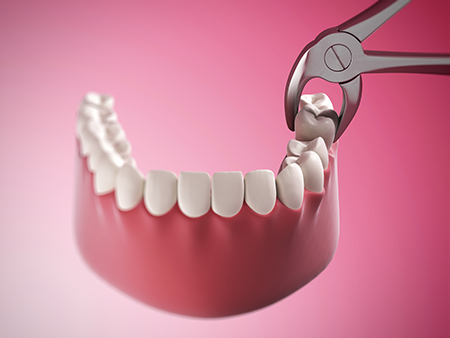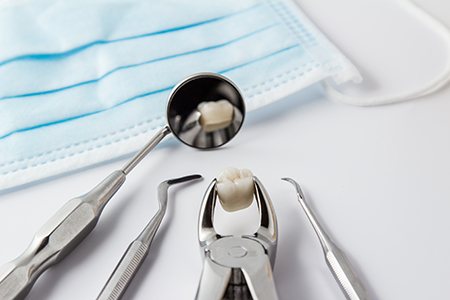Existing Patients
(515) 223-4194
New Patients
(515) 207-7409

Your dental team always aims to preserve natural teeth, but there are times when removal is the best route to protect overall oral health. An extraction is recommended when a tooth threatens nearby structures, causes persistent pain or infection, or cannot be predictably restored. Our team approaches each case with careful evaluation and a focus on minimizing discomfort while preserving long-term function.
We begin by reviewing your medical and dental history, current medications, and any factors that could affect healing. Digital radiographs help us see the tooth position, root anatomy, and surrounding bone so we can recommend the least invasive, safest option. If replacement will be needed later, we’ll discuss timing and appropriate restorative choices so you can make informed decisions.
Patients appreciate straightforward explanations about why a tooth must come out and what to expect next. We prioritize clear communication about the procedure, anesthesia choices, and post-extraction care so you feel prepared and supported from consultation through recovery.
An over-retained primary (baby) tooth
Sometimes a primary tooth does not loosen as its permanent successor attempts to erupt. When roots fail to resorb or the tooth becomes fused to the bone, it can block normal development and alignment. In these situations, removing the primary tooth can allow the permanent tooth to emerge and prevent orthodontic complications.
Extensive decay that leaves the tooth non-restorable
Dental caries can progress from a small defect in the enamel to widespread destruction of tooth structure and infection of the nerve. When a tooth lacks sufficient healthy structure for reliable restoration, extraction may be the safest option to stop the spread of infection and protect adjacent teeth.
Severe fractures or irreparable tooth damage
Teeth can sustain complex cracks or breaks that extend below the gumline or into the root. If the damage compromises long-term strength and function, removing the tooth can be more predictable and comfortable than attempts at extensive rebuilding.
Advanced periodontal disease
When gum disease has significantly reduced the bone and soft tissue that support a tooth, mobility and chronic infection can follow. In advanced cases, extraction may be necessary to stop ongoing tissue loss and to allow proper treatment of the surrounding areas.
Impacted or problematic wisdom teeth
Third molars often lack the room to erupt properly, which can lead to impaction, decay, or damage to neighboring teeth. Removing troublesome wisdom teeth—especially when they threaten surrounding structures—is a common preventive and corrective measure.
Teeth extracted as part of orthodontic planning
When jaw size and tooth size are mismatched, selective extractions can create space for a more functional, stable alignment. These decisions are made collaboratively with orthodontic providers to achieve the best long-term result.

Before any treatment begins, we conduct a thorough assessment to identify medical considerations that could influence the procedure. Tell us about medications, medical conditions, and any recent illnesses. With that information we tailor the plan—sometimes consulting with a physician or recommending a course of antibiotics or other precautions in advance.
We use digital imaging to evaluate root form and surrounding bone so we can choose the most appropriate technique. Local anesthesia is standard for comfort, and for patients with heightened anxiety or complex surgical needs, we can discuss sedation options to make the experience calm and manageable. Clear pre-operative instructions will help ensure the safest outcome.
Our goal is predictable, gentle treatment. Whether your extraction will be straightforward or will require a more advanced surgical approach, we explain each step, expected sensations, and approximate recovery so you know what to expect and how to prepare.
When a tooth is fully visible and the roots are uncomplicated, a simple extraction is often the most efficient approach. After the area is numbed with a local anesthetic, the dentist loosens the supporting tissues and removes the tooth with appropriate instruments. The focus is on minimizing trauma to the socket and surrounding tissues to support rapid healing and comfort.
We regularly offer strategies to reduce anxiety during routine extractions, from clear explanations and calming techniques to discussing sedative options when appropriate. Comfort and safety are the primary concerns at every stage of care.
Teeth that are broken below the gumline, impacted, or fused to bone frequently require a surgical approach. This may involve making a small incision in the gum and, when necessary, removing a small amount of bone to access and extract the tooth. In some cases, referral to an oral and maxillofacial specialist is the best course for complex removals.
Even with surgical extractions, patients receive local anesthesia and careful monitoring. Discussions about sedation, pre-operative instructions, and any special medical considerations take place well before treatment so the procedure proceeds smoothly and with confidence.

When a tooth is extracted, we’ll talk with you about replacement choices suited to your needs and goals. Restoring the missing tooth helps preserve chewing function, maintain the alignment of neighboring teeth, and support facial structure. Options vary by complexity and expected longevity, and we present them objectively so you can weigh the benefits.
Removable dentures provide a non‑permanent solution that can restore appearance and function when several teeth are missing. Fixed bridges use adjacent teeth as anchors and can be an efficient way to replace a single missing tooth, depending on the condition of those neighboring teeth. Dental implants, when appropriate, are a durable solution that replaces both the root and crown to closely mimic a natural tooth’s appearance and function.
Each replacement path has clinical considerations—bone volume, overall oral health, and timing of placement are key factors. We coordinate care so that restorative planning begins early, ensuring the best possible outcomes after healing.
Healing after an extraction is usually straightforward when you follow post-operative recommendations. Controlling bleeding, protecting the developing blood clot, managing discomfort, and maintaining good oral hygiene are the main priorities. We provide clear instructions tailored to the complexity of your extraction and your individual health profile.
Mild swelling and soreness are normal for a few days. Ice applied intermittently on the first day can reduce swelling, and taking prescribed or recommended pain medication as directed helps keep you comfortable. Avoiding strenuous activity and not disturbing the extraction site promotes stable clot formation and reduces the risk of complications.
Watch for signs of delayed healing—such as increasing pain, persistent or heavy bleeding, fever, or an unusual taste or odor—and contact us promptly if they occur. Early communication allows us to address concerns quickly and preserve a smooth recovery.
Gauze and pressure
You will be given gauze to bite on immediately after the extraction. Maintain firm but gentle pressure for the time your clinician recommends to help the initial clot form. Replace gauze only as instructed.
Protect soft tissues until numbness wears off
Do not chew on lips or cheeks while local anesthesia is active to avoid accidental injury.
Follow medication directions
If antibiotics or pain medications are prescribed, take them as directed. Over-the-counter analgesics can also be effective; use what your clinician recommends.
Protect the clot
Avoid rinsing vigorously, using a straw, or any action that creates suction in the mouth for the first 24–48 hours to prevent dislodging the clot.
Manage swelling
Apply an ice pack to the outside of the face intermittently on day one, and keep elevated when resting to reduce swelling.
Avoid tobacco
Smoking or using tobacco products can interfere with clotting and healing; refrain for at least the first week following the extraction.
Soft foods and fluids
Stick to soft, cool or lukewarm foods for the first few days. Hydrate well but avoid carbonated or alcoholic beverages until you are healed sufficiently.
Oral hygiene
Continue gentle brushing and, after the first day or two, use a mild saltwater rinse to keep the area clean without disturbing the healing socket.
Follow-up care
If sutures were placed or if your case required extra monitoring, keep the follow-up appointments so we can confirm proper healing and plan any restorative steps.
If you notice ongoing bleeding, increasing pain, worsening swelling, or any other unusual symptoms, contact the office so we can assess and advise appropriate next steps.

Our West Des Moines practice has cared for local families for decades, combining clinical experience with modern techniques to make extractions as predictable and comfortable as possible. We approach every procedure with attention to detail—planning for safety, pain control, and efficient healing—so you can return to normal activities with confidence.
Your comfort is important to us. From gentle anesthesia to personalized post-operative instructions, our team supports you throughout the process and coordinates any restorative care you may need after healing. We prioritize clear communication and a conservative approach that preserves health and function whenever possible.
When extractions are necessary, we work with you to outline next steps for replacing missing teeth, protecting adjacent teeth, and restoring full chewing function. Our goal is to help you move forward with a healthy, stable smile.
Summary: Tooth removal is sometimes the most appropriate way to stop pain, control infection, and protect surrounding teeth and tissues. With careful evaluation, modern techniques, and thoughtful aftercare, most patients heal predictably and comfortably. Contact us for more information or to discuss whether extraction is the right option for your situation.
The most common reasons for tooth loss include advanced periodontal disease, extensive tooth decay, and facial trauma. According to statistics, gum disease is responsible for close to 70% of tooth loss in adults. Although less frequent than the preceding three reasons, it should also be noted that specific diseases, drugs, smoking, and poor nutrition contribute to the risk of tooth loss.
The Centers for Disease Control and Prevention report that in the United States, an average of 12 teeth (including the wisdom teeth) are lost by the age of 50. Also, 26% of adults between 65 and 74 years of age have lost all their teeth.
Every patient and every situation is different. However, when a tooth and the surrounding tissues are numbed with a local anesthetic, you should only expect to feel a bit of pressure, but no pain as the tooth is being loosened from the surrounding tissues and extracted. For patients who are apprehensive and for some surgical extractions, our office will discuss our options in dental sedation to provide further relaxation and reduce any sense of discomfort.
While it's normal to feel some tenderness and swelling following an extraction, the degree of these sensations can vary. It mostly depends on the complexity of the extraction and the body's response to the procedure. We'll recommend or prescribe the appropriate pain medication to help ensure your comfort and give you specific instructions for maximum effectiveness and safety.
Typically, the recovery period following a simple extraction is shorter than a surgical extraction. However, a patient's overall health, habits, the size and location of the tooth, and other variables can influence recovery and healing. To speed up the recovery and avoid any complications, patients must follow the given at-home instructions diligently. We'll carefully review what to expect following your procedure and go over your post-op instructions.
Smoking interferes with blood clot formation, which is an essential first step in the healing process. Blood clot formation not only provides a protective layer to cover the underlying exposed bone and nerve endings, but it also supports the growth of new tissue. Cigarette smoke also contains chemical toxins that can disrupt the healing process and lead to problems such as continued inflammation, infection, or dry socket.
In a very small percentage of cases, a condition known as dry socket can develop in the aftermath of a dental extraction. This painful condition can arise when the blood clot in the extraction site doesn't form properly or gets dislodged. With dry socket, you may experience throbbing pain and symptoms such as bad breath and an unpleasant taste in your mouth. As skilled providers of care, our office will provide immediate treatment to alleviate your discomfort and promote healing.
The last teeth in your mouth to develop, wisdom teeth often do not have enough room to fully erupt or may be positioned in the wrong direction. These issues can affect your dental health as well as overall wellbeing. While some individuals never develop all their wisdom teeth, and a few have sufficient space for them, there are many people with partially or fully impacted third molars. Our office will monitor the development, position, and health of your wisdom teeth and will advise you if and when extractions are indicated.
After a tooth is removed, bone-grafting material is sometimes placed in the socket to promote healing and encourage new bone development. This procedure is often performed to support the eventual and successful placement of a dental implant.
At the office of Smiles for Life, we strive to make dental care affordable and accessible. Depending on the type or complexity of the extraction and other variables, the cost of the procedure can vary. Based on our diagnostic findings, our office will inform you of the healthiest choices in care, explain the fees, discuss insurance coverage, and explain your payment options.
Many dental plans offer some level of coverage for tooth extractions. We'll advise you if your plan covers the full cost of the procedure and if there is any out-of-pocket expense. Our business office will work with you to maximize your insurance benefits as much as possible while helping you minimize any out-of-pocket expenses.
A tooth extraction may be recommended when a tooth threatens nearby structures, causes ongoing pain or infection, or cannot be predictably restored. Dentists consider extractions only after evaluating whether conservative treatment can preserve the natural tooth. Common reasons include advanced decay, severe fractures, periodontal disease, impacted wisdom teeth and teeth that impede normal development.
The decision to extract balances short‑term relief with long‑term function and oral health. Your clinician will explain why removal is the safest option for your situation and discuss appropriate next steps. Thoughtful planning helps protect adjacent teeth and supports a smooth recovery.
Determining whether a tooth can be saved starts with a thorough review of your medical history, medications and a focused dental exam. Digital radiographs reveal root anatomy, surrounding bone and the extent of decay or infection so clinicians can assess restorability. The team also evaluates periodontal support, fracture patterns and how the tooth contributes to chewing and alignment.
When restoration is feasible, options like root canal therapy, crowns or periodontal treatment may be recommended. If those approaches are unlikely to provide durable function, extraction becomes the more predictable choice. Clear communication about benefits, risks and replacement options helps you make an informed decision.
A simple extraction is used when the tooth is fully visible in the mouth and the roots are straightforward. After numbing the area with local anesthesia, the dentist loosens the supporting tissues and removes the tooth with instruments designed to minimize trauma to the socket. Simple extractions are typically quicker and involve less post‑operative discomfort than surgical removals.
Surgical extractions are necessary when a tooth is broken below the gumline, impacted, or fused to bone and cannot be removed intact. The clinician may make a small incision in the gum and remove a bit of bone or section the tooth for safer removal, and sutures are sometimes placed to support healing. Complex cases may be referred to an oral and maxillofacial specialist for advanced surgical care.
Local anesthesia is the standard method to ensure comfort during most extractions by numbing the treatment area so you do not feel pain. For patients with anxiety or for longer, more complex procedures, additional sedation options such as nitrous oxide, oral sedatives or monitored intravenous sedation can be discussed. Your clinician will review medical history and current medications to choose a safe, effective option for your needs.
All sedation choices include monitoring and clear pre‑operative instructions to promote safety. If stronger sedation is recommended, plan for a responsible adult to drive you home and remain available after the appointment. The goal is a calm, controlled experience while maintaining safety and effective pain control.
Before an extraction, share your full medical history, current medications and any allergies so the team can tailor care and reduce risk. Follow pre‑operative instructions regarding eating, medication adjustments and blood thinner management when directed by your physician or dentist. Arrange transportation if you will receive sedation that impairs driving or coordination.
Wear comfortable clothing and plan time to rest after the procedure, especially after surgical extractions or sedation. If antibiotics or other precautions are recommended because of medical conditions, follow those instructions closely to support a safe outcome. Clear communication with your dental team helps ensure the best possible experience.
Initial recovery after an extraction typically involves mild swelling, soreness and clot formation in the socket, with the first 24 to 72 hours being the most active period of healing. Follow post‑operative instructions to control bleeding, protect the clot and manage pain; these measures significantly reduce complications. Most soft tissue healing occurs within one to two weeks, and discomfort usually decreases steadily during that time.
Bone remodeling and full maturation of the extraction site take longer, often several months, which is important to consider when planning long‑term replacement like implants. Your clinician will advise on timelines for placing restorations or implants based on the complexity of the extraction and your individual healing. Keeping follow‑up appointments allows the team to confirm healing and schedule any restorative care at the appropriate time.
While most extractions heal without issue, complications can include excessive bleeding, infection, delayed healing and a painful condition called alveolar osteitis or dry socket. Signs that warrant prompt attention include increasing or severe pain after the first few days, persistent heavy bleeding, swelling that worsens rather than improves, fever or an unusual taste or odor. Early evaluation allows the team to treat problems before they escalate.
If you experience numbness that persists beyond the expected duration, difficulty breathing or swallowing, or any other emergency symptoms, seek immediate care. For non‑emergent concerns, contacting the office as soon as symptoms appear lets clinicians advise you on next steps and schedule follow‑up care. Timely communication helps protect healing and comfort.
Replacement options after extraction include removable dentures, fixed bridges and dental implants, each with distinct benefits and clinical considerations. Timing for replacement depends on bone volume, the location of the extraction, infection control and your overall oral health. In many cases, the clinician waits for adequate bone healing—often a few months—before placing an implant, though immediate implant placement is possible in selected situations.
Your dentist will evaluate the best restorative path to preserve chewing function, maintain alignment and support facial structure. Treatment planning often begins before extraction so you understand timing and options for long‑term care. Coordination between surgical and restorative phases ensures a predictable, functional outcome.
Yes, extractions are sometimes part of orthodontic planning when jaw and tooth size are mismatched and space must be created for proper alignment. These decisions are made collaboratively between the dentist and the orthodontist to achieve a stable, functional bite and an esthetic result. Removing selected teeth can simplify movement and reduce long‑term relapse when done for the right clinical reasons.
When extractions are planned for orthodontic purposes, timing and which teeth to remove are coordinated carefully so restorative and alignment goals are met. Your treatment team will explain how extraction supports the overall plan and what to expect during the movement and retention phases. Close communication ensures that both orthodontic and restorative needs are addressed.
Our West Des Moines practice combines decades of experience with modern techniques to make extractions predictable and comfortable while prioritizing safety and long‑term oral health. Clinicians use digital imaging, individualized treatment planning and clear communication to explain why extraction is recommended and how recovery will proceed. Attention to anesthesia choices, gentle surgical technique and thorough post‑operative instructions supports efficient healing and patient comfort.
When restorative work is needed after healing, the team coordinates care so replacement options are planned early and executed with the patient’s goals in mind. If a case requires advanced surgical management, we refer to or collaborate with oral and maxillofacial specialists to ensure the best outcome. You can expect a conservative, patient‑focused approach from consultation through restoration.